By: Wlabs, Guatian Laboratory

In the previous article "Guatian Academy GameFi Public Chain Research Series Part One - Ethereum's Development and Upgrade Path", we initially introduced the development history of Ethereum and the basic information of Ethereum 2.0 upgrade, thus extending into two main sub-tracks of Layer2, Optimistic Rollup and ZK Rollup.
If we analogize Ethereum to a company, we can simply understand that the Ethereum 2.0 upgrade is a restructuring of the internal management structure of the company, changing from the original chain structure to a beacon chain-sharding (Shards) overall structure. Layer2 then further outsources the tasks that need to be executed on this overall structure, further reducing the company's burden, improving efficiency, and enhancing the overall task processing capacity.
In the second research article of this series, we will further explore Layer2 solutions and delve into the Optimistic Rollup track.
I. Overview of Layer2 Solutions
To understand the Layer2 expansion solution, we first need to confirm the concept of Layer2.
What is Layer2? Layer 2 refers to off-chain networks, systems, or technologies based on the underlying blockchain (Layer 1) used to scale the underlying blockchain network. There are currently two methods of classifying Layer2 in the market. In a narrow sense, Layer2 inherits the security of the Ethereum chain and conducts transactions bundled with Layer2 Ethereum, while Layer2 is only responsible for computation. ZK and optimistic rollup are the orthodox Layer2. In a broad sense, Layer2 includes all Ethereum scaling solutions, mainly including the following 5 types:
-
01Sidechain: A sidechain is an independent blockchain that operates in parallel with Ethereum. It achieves "atomic swaps" by locking a certain amount of assets in the main chain's smart contract and then minting the same amount of assets on the sidechain. The main problem with sidechain solutions is weak security, but they have good independence and flexibility. The well-known Polygon is a representative of Ethereum sidechains. Some people also consider the BNB chain as an Ethereum sidechain, although BNB is also an EVM-compatible chain, strictly speaking, it is considered a replica of Ethereum and can operate independently of Ethereum, so we do not classify it as a sidechain.
-
02State Channel: State channels complete off-chain transactions by establishing exclusive payment channels and multi-signature addresses between traders. The final calculation results are recorded on-chain only when settlement is required. They are characterized by fast speed and low fees. Representative technologies include the Lightning Network (based on Bitcoin) and the Raiden Network (based on Ethereum).
-
03Rollups: As explained in a previous article, rollups "outsource" data execution work to Layer2 and batch submit it to the main chain. They are mainly divided into optimistic rollup and ZK rollup. Optimistic rollup treats data validity optimistically. If no one questions the data and submits fraudulent proof within a specified time, the data is considered true and accurate; otherwise, fraud handling mechanisms are activated to revoke the transaction. ZK rollup bundles multiple transactions together and publishes them to L1, while simultaneously publishing a proof (using zero-knowledge proof technology) to assert the validity of these transactions.
-
04Validium: Validium also uses zero-knowledge proof, but unlike ZK rollup, it only uploads the state root and zero-knowledge proof to the mainnet, while the transaction data is stored in Layer2, resulting in higher throughput but sacrificing some security. Because both use zero-knowledge proof, many people consider Validium as a variant of ZK rollup. Therefore, another way of classification is to separate ZK and optimistic into two categories and classify Validium under ZK. The game chain ImmutableX mainly utilizes the underlying technology of Validium.
-
05Plasma: Plasma is a framework for Ethereum Layer2 extension, also known as "a chain within a chain." It locks assets on the main chain and transfers transactions to the child chain for processing. The child chain periodically submits state updates to the main chain. This not only speeds up settlement but also significantly reduces fees. The difference between the child chain and the sidechain is that the child chain uses root storage, allowing users to safely exit the Plasma chain in case of any errors, while the sidechain does not have this functionality. In general, the child chain is more closely related to the main chain.
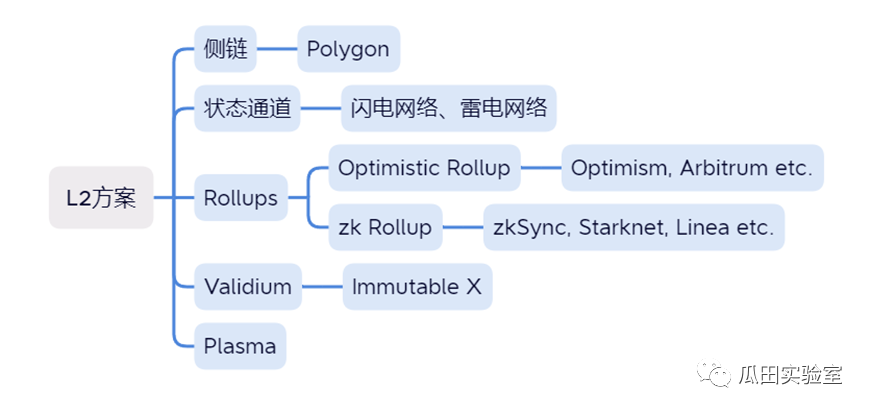
In this article, we will focus on explaining the sidechain solution Polygon PoS, the two main projects of Optimistic Rollup - Arbitrum and Optimism, and the BNB ecosystem projects opBNB and COMBO, which are both replicas of Ethereum and Optimistic Rollup. We will mainly elaborate on the basic technical principles, ecology, and support for blockchain games of these public chain projects. ZK Rollup and Validium will be discussed in the third article.
II. Polygon PoS Analysis
Introduction to Polygon
Polygon, originally known as Matic, was initially a blockchain scalability platform, referred to as the "blockchain internet of Ethereum." As the ecosystem continued to develop, the platform expanded from a single Layer2 solution to a "network of networks," aiming to address the transaction speed and scalability issues of the Ethereum mainnet, with a primary focus on blockchain games and NFTs. Categorizing Polygon as a sidechain is not entirely accurate because within Polygon's overall product matrix, the sidechain product Polygon PoS is the foundation of Polygon, while the ZK Rollup matrix consisting of Polygon zkEVM, Polygon Miden, Polygon Zero, and Polygon Nightfall is Polygon's potential growth point. In the Polygon 2.0 upgrade plan released this year, the team is preparing to upgrade Polygon PoS to zkEVM Validium. Due to space limitations and thematic classification, in this article, we will mainly analyze the sidechain product Polygon PoS, while the ZK part will be further discussed in the next article.
Technology
Although Polygon PoS is based on Ethereum, it benefits from faster speed and higher scalability, with transaction volume consistently exceeding that of the Ethereum mainnet (approximately 2 million daily transactions), while gas fees are only 0.1% of Ethereum's.
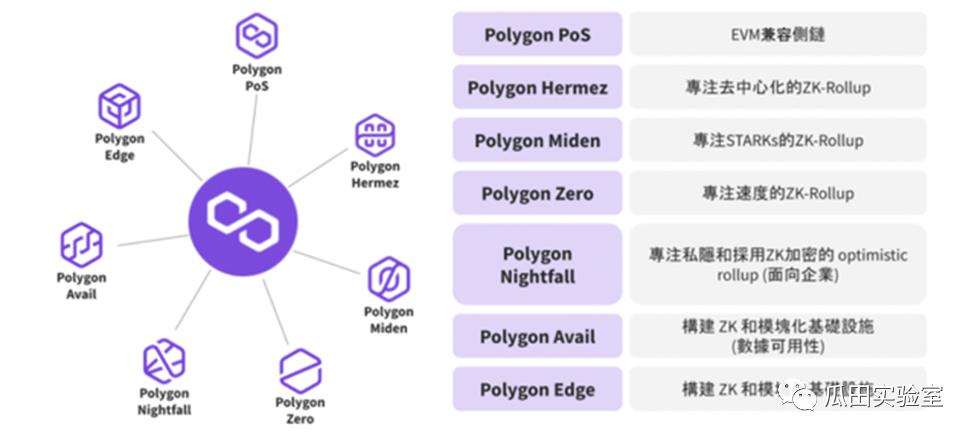
Polygon PoS is an EVM (Ethereum Virtual Machine) compatible sidechain that was launched on June 1, 2020, and is currently the main business of Polygon. Polygon PoS is also the most mature Ethereum sidechain solution to date. The overall architecture of Polygon PoS can be divided into three layers:
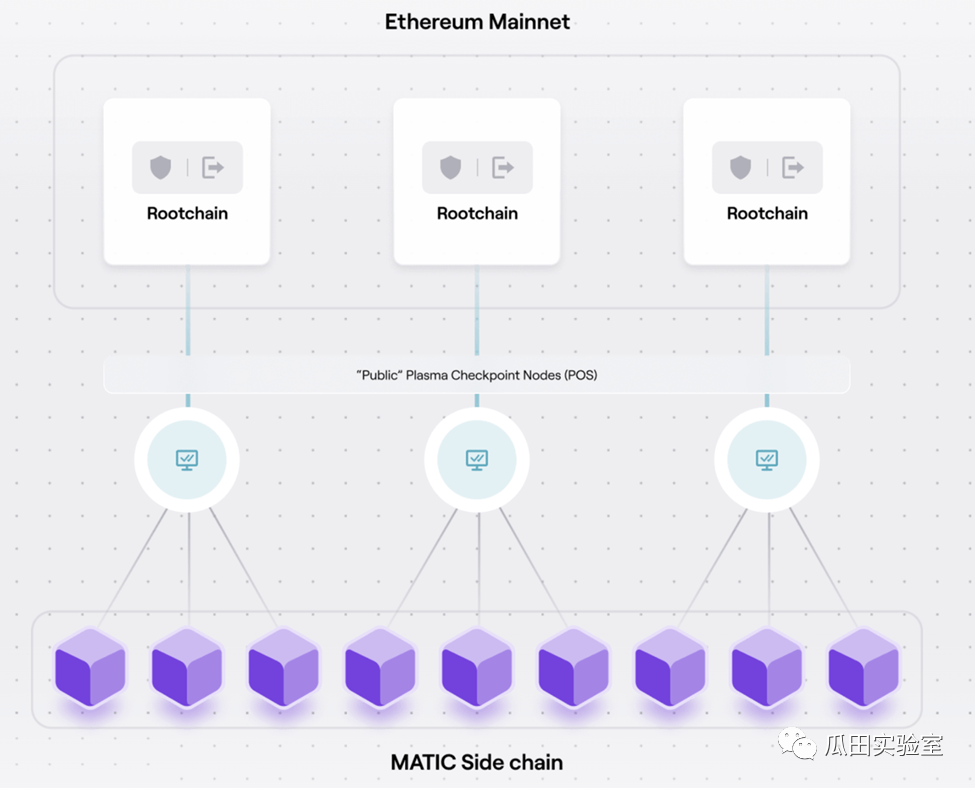
-
Ethereum Layer: This layer consists of a series of Ethereum smart contracts responsible for processing on Ethereum and utilizing Ethereum's security as a shield, while the Matic token is also staked in this layer.
-
PoS Checkpoint Node Layer: This layer is the core layer of Polygon, responsible for producing and verifying Matic sidechain blocks. PoS nodes can listen to events on the Ethereum chain, pass information to the Matic sidechain, and periodically publish Matic-generated blocks to the Ethereum chain, thereby achieving synchronization of information between the Matic sidechain and the Ethereum mainnet.
-
Matic Sidechain Layer: Responsible for transactions, shuffling, block formation, and periodically publishing checkpoints to the node layer.
Polygon's unique hybrid structure enables Polygon POS to support the Plasma framework and inherit Ethereum's security. The PoS Bridge further ensures the security of the chain through the same set of validators and staked MATIC.
Ecosystem
Since its launch in 2020, Polygon entered a period of rapid growth in Q2 2021 and became the third public chain with a complete ecosystem after Ethereum and BNB. By the first quarter of 2023, the number of projects in the Polygon ecosystem has exceeded 53,000.
Benefiting from the flourishing DeFi sector in the early stages of platform development, DeFi projects expanded rapidly. For example, leading DeFi projects such as Uniswap, Aave, and Curve chose Polygon as their first choice for multi-chain deployment. In April 2021, Polygon launched a $150 million DeFi development fund to reward Matic projects. While DeFi projects in the Polygon ecosystem have some innovative shortcomings, the overall TVL ranking is fifth and has been surpassed by the rising star Arbitrum.
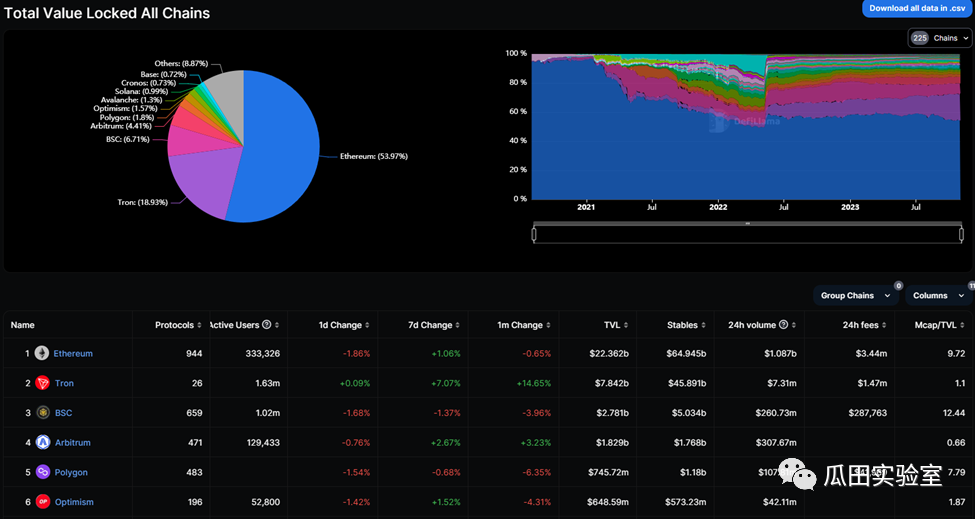
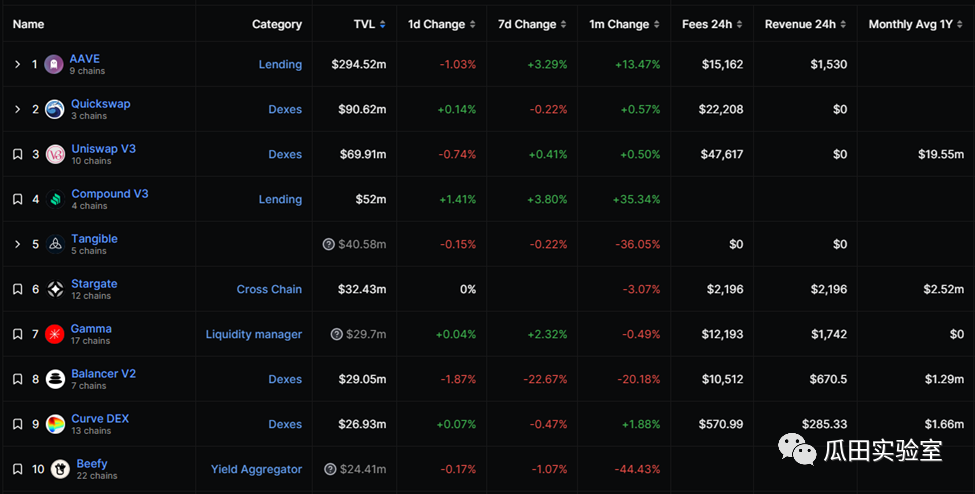
Data Source: Defillama
Polygon also has a strategic focus on NFTs. In June 2021, Opensea first supported the Polygon chain, after which Ethereum and Polygon almost split the high-end and low-end NFT markets. Many international brands have already launched their NFTs on Polygon, including Starbucks, Mastercard, Adidas, and others, gradually attracting more brands and creating a positive cycle. Other popular projects include Lama Kings, Doodle Changs, y00ts, Bungo Beanz, and Super Pengs.
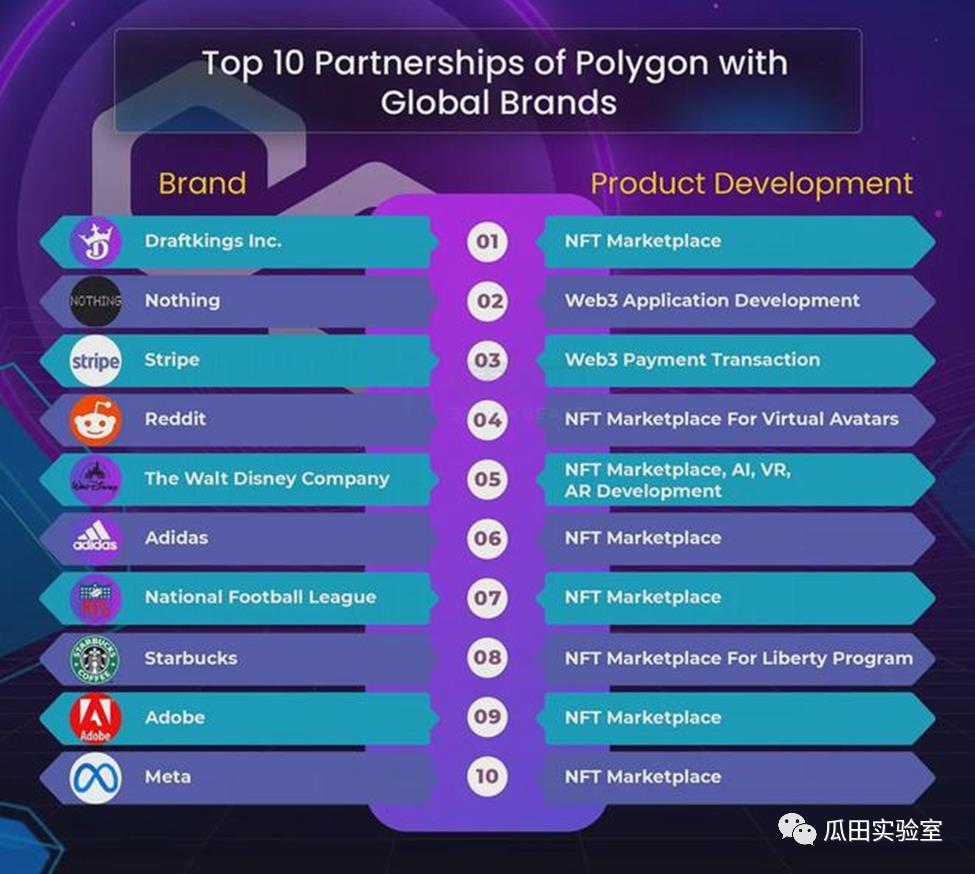
In the gaming and metaverse sector, according to Footprint's data, the number of active gaming projects on the Polygon chain has reached 468, ranking third after BNB and Ethereum. Specifically, the two leading metaverse projects, Decentraland and The Sandbox, deployed on the Polygon chain in April and June 2021, respectively. Other popular games include Pixels, Arc8, Benji Bananas, Sunflower Land, and Skyweaver.

In July 2021, Polygon announced the establishment of Polygon Studios, focusing on investments in the NFT, Gaming, and Metaverse sectors. In terms of offline promotion, Polygon has been frequently involved. Based on its low-cost and fast transaction experience, Polygon has become one of the best choices for Web2 and traditional enterprises looking to explore blockchain or web3.
Pros and Cons Summary
As the earliest mature Ethereum Layer2 ecosystem, Polygon PoS has a clear first-mover advantage, and its advantages are also very apparent:
-
Speed: Intuitive, efficient bridging, deposit, and withdrawal, with a transaction speed of up to 7000 tps, far exceeding the performance before the Ethereum upgrade (15 tps);
-
Security: Relies on Ethereum and shares its security;
-
Compatibility: Full EVM compatibility means smart contracts can be deployed directly on the Polygon chain;
-
Low cost: Approximately 0.1% of Ethereum
Low transaction fees and significant speed make Polygon the best choice for high-frequency trading projects (DeFi, GameFi, etc.) within the Ethereum ecosystem. Although the rise of second-layer star projects such as Arbitrum, Optimism, and zkSync will to some extent affect the market landscape of Polygon, Polygon itself is also evolving and embracing the ZK track comprehensively, acquiring and launching a series of products based on ZK technology. We will analyze this in detail in the next article.
3. Arbitrum Project Analysis
Introduction to Arbitrum
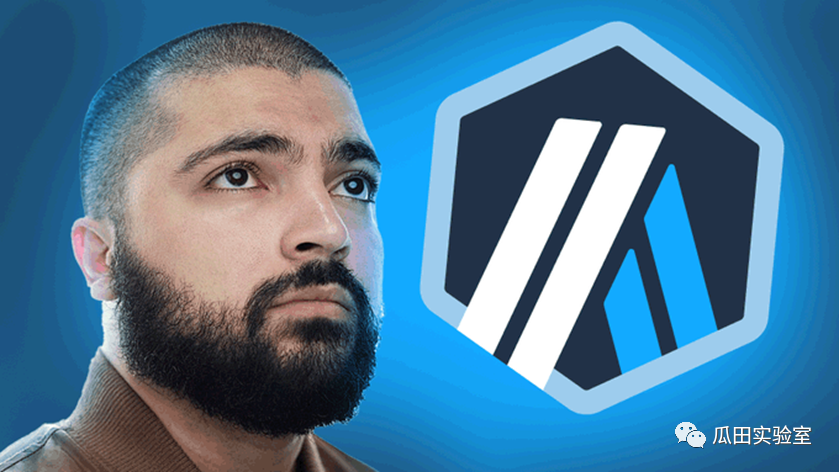
As a leading project in Layer2, Arbitrum has always been surrounded by a halo. Especially during the coin issuance period in the first half of 2023, it became one of the hottest topics in the chain circle, attracting a large number of people eager to join the Layer2 ecosystem. Our statistics from Defillama also show that Arbitrum has surpassed many public chain competitors, ranking fourth in total locked value (TVL) after ETH, BSC, and TRON, and even surpassing the veteran Layer2 sidechain Polygon, firmly establishing itself as the leader in Layer2.
Arbitrum went live in May 2021: Arbitrum One officially launched on the Ethereum mainnet. In October 2021: The public testnet of Arbitrum Nova was launched. In 2022, the plan for Arbitrum Orbit is steadily progressing, designed as a Layer 2 solution specifically for NFT and virtual reality (VR) applications. This will provide more scalability for digital assets and applications in the virtual world.
Arbitrum now has a TVL of up to $59.3 billion, a circulating market value of $14.5 billion, and a fully diluted valuation of $113 billion, with no new unlocks in the next 6 months. The current daily active addresses are around 150,000, with a transfer volume of around 620,000, closely following Polygon and firmly holding its position in the top tier.

Technology
Arbitrum is a Layer 2 scalability solution that follows a similar technological route to Optimistic Rollup, assuming all transaction verifications are honest but setting a challenge period during which anyone can raise a challenge. The system introduces two different roles to ensure transaction execution: Verifiers and Managers. Verifiers are responsible for processing transactions and receive Ethereum as a reward, while Managers monitor the correct execution of transactions by Verifiers. Before transactions return to the Ethereum mainnet, there is a 7-day challenge period during which all Managers can challenge transactions. If any malicious activity is confirmed during this period, the wrongdoer will lose the staked tokens. This method ensures the security of Arbitrum as long as at least one honest Manager is present during the challenge period.
The project mainly includes the following major product lines:
-
Arbitrum One: Based on Optimistic Rollup technology, Arbitrum One achieves high-performance and low-cost smart contract execution by verifying transactions on the Ethereum chain. Arbitrum One provides a fast and cost-effective way to execute Ethereum smart contracts, alleviating congestion issues on the Ethereum network and promoting performance improvements for DeFi applications and the NFT market. Most applications (DeFi and NFT, etc.) are deployed on this product line, the flagship rollup platform of Arbitrum.
-
Arbitrum Nova: Utilizing zk-Rollup technology, Arbitrum Nova verifies transactions using zero-knowledge proofs, enhancing security and efficiency. The introduction of Arbitrum Nova adds diversity to Arbitrum, allowing developers to choose different solutions to build applications that meet the needs of various projects. Arbitrum Nova is mainly used for high-throughput applications, such as gaming and social applications.
-
Arbitrum Orbit: Arbitrum Orbit is Arbitrum's ecosystem development plan, aiming to provide tools, libraries, and support to facilitate developers in building applications on Arbitrum. The goal of Arbitrum Orbit is to expand the Arbitrum ecosystem, provide resources and support to developers, and promote application development and deployment.
These three components collectively drive the development of Arbitrum, providing more technical choices and ecosystem support, attracting more developers and projects, and further promoting the growth of the Ethereum ecosystem.
Ecosystem
The Arbitrum ecosystem has reached 600 projects, including many excellent projects such as GMX, Radiant, TreasureDAO, and Camelot, bringing a wide range of use cases to Arbitrum. Games projects like Treasure DAO and Pirate Nation have experienced explosive growth, bringing significant activity to Arbitrum.
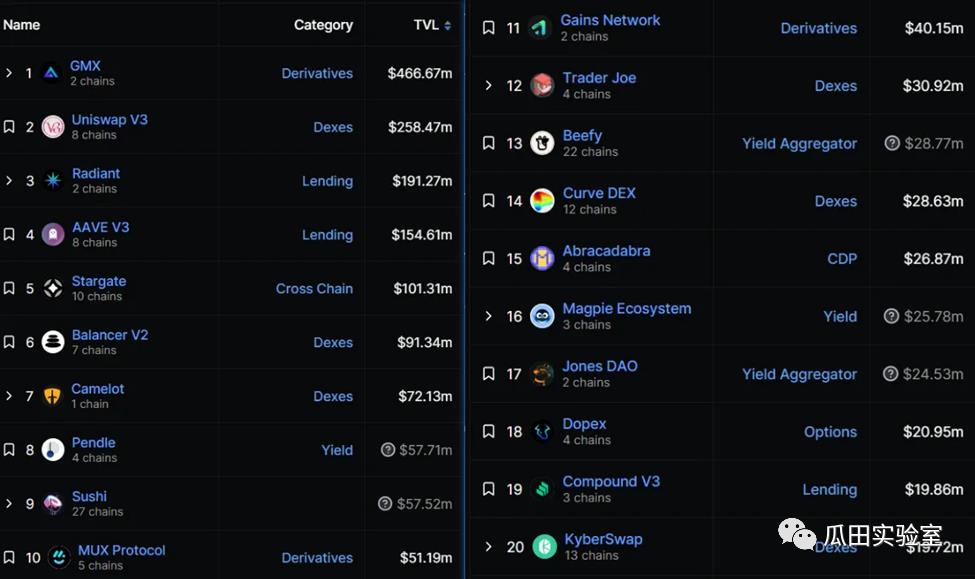
Pros and Cons Summary
Arbitrum inherits the advantages of Optimistic Rollup and has the following strengths:
-
High performance: Arbitrum improves transaction throughput and reduces costs by optimizing smart contract execution, alleviating congestion issues on the Ethereum network.
-
Low cost: As transactions are executed on Layer 2, Arbitrum significantly reduces Gas fees on the Ethereum main chain, lowering the cost for users to participate in DeFi and NFT market activities.
-
Compatibility: Arbitrum is compatible with Ethereum smart contracts, supporting the migration of existing dApps and smart contracts.
-
Security: Arbitrum adopts Layer 2 extension security measures, such as Rollup technology, to ensure the security of user funds and data.
-
Ecosystem support: Attracting well-known projects within the Ethereum ecosystem, providing users with more choices, and offering growth opportunities for DeFi and NFT projects.
Arbitrum's disadvantages include:
-
Centralization: Compared to the Ethereum main chain, Layer 2 solutions generally have a higher degree of centralization, which may raise some security and trust issues.
-
New learning curve: New users may need to learn new workflows and usage methods, increasing the learning curve for some users. For example, transferring ETH mainnet assets to the Arbitrum Layer 2 network through bridging.
-
Low network effect: It takes time to establish sufficient network effects to attract more users and developers.
IV. Analysis of the Optimism Project
Introduction to Optimism
Optimism is an Ethereum Layer 2 solution that moves transfers, smart contracts, and more to the Optimism chain for processing, recording only the final results on Ethereum, significantly reducing transaction fees for each transaction.
The Optimism project was launched in early 2020 and released a whitepaper. By the end of 2020, it launched a testnet to verify the feasibility and security of its technology. On the testnet, developers and projects could start deploying smart contracts and applications on Optimistic Ethereum. In 2021, Optimism actively collaborated with the Ethereum community to promote the development of Layer 2 solutions. The Ethereum community recognized the urgent need for scalability, and Optimism provided a viable option. The Optimism mainnet was officially launched at the end of 2021. This marked the launch of the first orthodox Layer 2 scaling solution on Ethereum. Subsequently, some DeFi projects and decentralized exchanges began migrating to Optimistic Ethereum to reduce transaction costs and improve performance. Since its mainnet launch, Optimism has gained widespread adoption and attracted many projects to deploy applications, including DeFi projects, NFT markets, and other applications in the Ethereum ecosystem.
The development of Optimism demonstrates its significant role in addressing Ethereum network congestion and high transaction fees, as well as its continuous growth and adoption within the Ethereum ecosystem. It represents an important advancement of Layer 2 scaling technology in the blockchain field.
Technology
When discussing OP's technology, it is essential to mention the OP Stack. The OP Stack can be understood as a set of open-source software components that allow anyone to build their own L2 blockchain on Ethereum using Optimistic Rollup.
The OP Stack consists of four main components:
-
Mainnet: The OP mainnet is a low-cost and fast Ethereum L2 network compatible with the Ethereum Virtual Machine (EVM).
-
Contracts: Smart contracts that implement the core logic and functionality of the OP Stack. OP contracts include the State Transition System (STS), Fraud Proofs (FP), State Commitment Chain (SCC), and Canonical Transaction Chain (CTC).
-
Services: Providing data availability, synchronicity, and communication between L1 and L2.
-
Tools: Used to facilitate the development, testing, deployment, monitoring, and debugging of OP Stack-based blockchains.
OP Stack will be built as a forkable, modular, and scalable blockchain infrastructure. To achieve this vision, all types of L2 need to be integrated into a single Superchain, combining separate L2s into an interoperable composite system. Deploying L2 will be as simple as deploying smart contracts on Ethereum today. Essentially, the Superchain is a horizontally scalable blockchain network that shares Ethereum's security, as well as communication layer and development tools. The Superchain can be likened to a Cosmos based on Ethereum security, but now OP Stack has become a Cosmos Killer. Benefiting from the OP Stack or Superchain architecture, five public chain projects including Optimism, Base, Zora, Aevo, and Public Goods Network have already launched, and opBNB recently went live.
Architecturally, the OP Stack can be divided into six layers from bottom to top: DA Layer, Sequencing Layer, Derivation Layer, Execution Layer, Settlement Layer, and Governance Layer. Each layer of the OP Stack is a modular API that can be combined and decoupled at will. The most critical layers are the DA layer, Execution layer, and Settlement layer, which constitute the primary workflow of the OP Stack.
-
DA Layer: The Data Availability layer is the original data source of the OP Stack, which can use one or more data availability modules to obtain input data. Currently, the primary DA layer is Ethereum, but there will be more chains in the future.
-
Execution Layer: The state structure in the OP Stack, providing possibilities for EVM or other VMs, adding support for L2 transactions initiated on Ethereum, and increasing additional L1 data costs for each transaction in the comprehensive cost of publishing transactions to Ethereum.
Settlement Layer: This layer consolidates L2 transaction data on the OP Stack and sends the information to the target chain for settlement after L2 confirmation. In the future, it is also expected to access ZK and other validity proof mechanisms to bridge the gap between different chains, and even connect OP system L2 and ZK system L2.
Ecosystem
DeFi is always a major focus of public chains. The prosperity and innovation of DeFi projects attract and accommodate a large amount of liquidity, revitalizing the entire public chain ecosystem. The DeFi ecosystem of OP is relatively complete, with decentralized exchanges, lending, and more. For example, Velodrome is the largest DEX on OP, and Sonne Finance is the native lending platform on OP, ranking second in TVL among lending projects.
In the GameFi field, unfortunately, there are no standout projects on OP, neither the "chain game Nintendo" like Tresure DAO nor innovative projects like Trident's Risk to Earn. However, OP has a trump card in the gaming sector, which is Op Craft based on Op Stack. Full-chain games represent a new paradigm. When it comes to pure on-chain games, you might first think of "dark forest," and expanding pure on-chain games further, a popular term now is "Onchain Autonomous World," perhaps the most blockchain-like gameplay, originating from games but transcending games. This trendy term was pioneered by Op Craft.
Pros and Cons Summary
Optimism has four major advantages: EVM equivalence, data security, speed, and cost.
-
Optimism is one of the most EVM-compatible chains, with a focus on further equivalence with EVM. Optimism can support any Ethereum application using its Optimistic Virtual Machine (OVM), which is an EVM-compatible virtual machine. Developers can deploy any Ethereum-based dApp to Optimism with minimal architectural changes. This allows decentralized applications (dApps) built on Ethereum to seamlessly integrate with Optimism.
-
Optimism's rollup architecture can obtain security from the Ethereum mainnet. Transactions are processed on Optimism, but transaction data is written to and stored on Ethereum. This allows Optimism to inherit Ethereum's security while maintaining scalability.
-
Optimism can achieve 10-100x scalability improvements based on the nature of transactions. Optimism has near-instant transaction finality, allowing users to check their transaction results almost immediately.
-
Transactions on Optimism are also inexpensive, costing only about 1% of Ethereum transaction costs.
Optimism has three main drawbacks: long withdrawal times and high costs, potential incentive misalignment among network participants, and underlying L1 scrutiny of transactions.
-
Official withdrawals through Optimism's bridge require a 1-week waiting period due to the 1-week challenge period for fraud proofs. It is important to note when using the network, as withdrawals through the main bridge cannot be canceled once submitted. Due to the security measures implemented in the bridge, withdrawals through the main bridge are costly and may cost over $100. Such long and costly withdrawal periods may have a negative impact on adoption and composability.
-
The network relies on incentivized validators to challenge fraudulent proposals. If there are fewer or no fraudulent proposals, validators receive fewer or no rewards from operating nodes, as they only receive rewards when successfully challenging fraudulent proposals. This may inhibit validator node operation.
-
If specific transactions have sufficient value, the Sequencer may bribe Ethereum miners to allow fraudulent proposals to pass at very low costs during the computation check period.
V. Analysis of the opBNB and COMBO Projects
opBNB
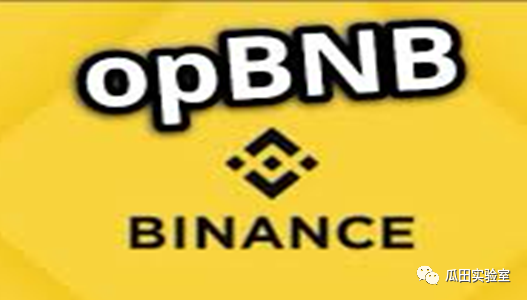
免责声明:本文章仅代表作者个人观点,不代表本平台的立场和观点。本文章仅供信息分享,不构成对任何人的任何投资建议。用户与作者之间的任何争议,与本平台无关。如网页中刊载的文章或图片涉及侵权,请提供相关的权利证明和身份证明发送邮件到support@aicoin.com,本平台相关工作人员将会进行核查。




